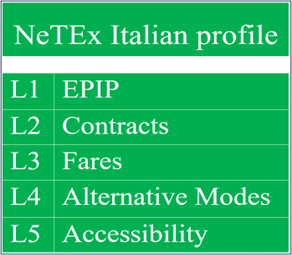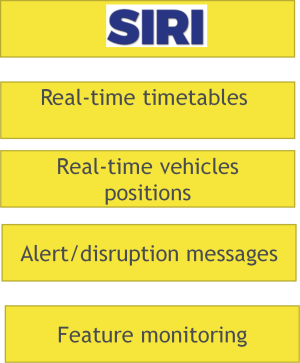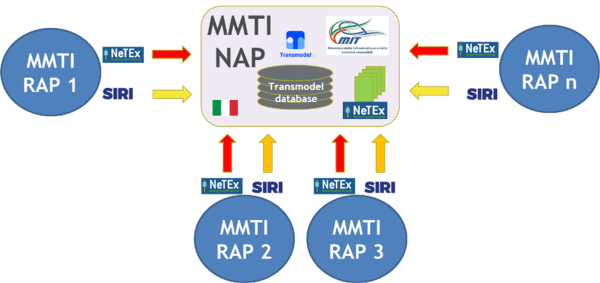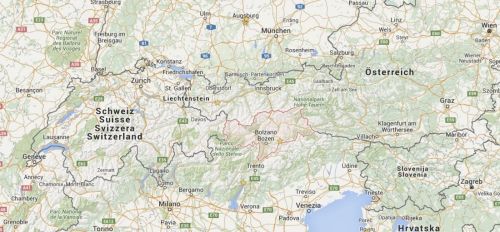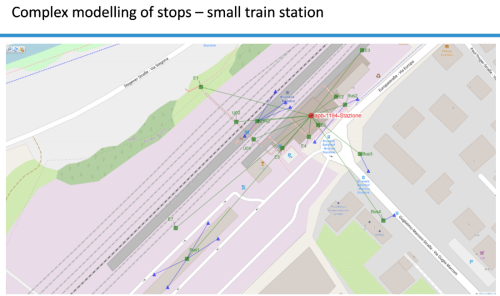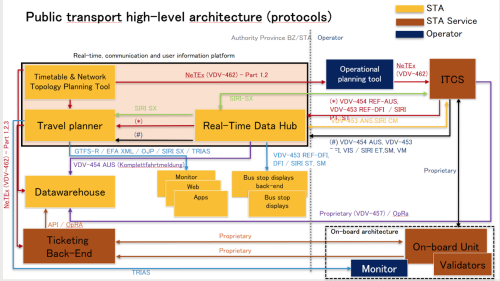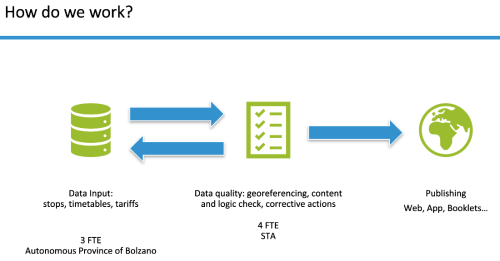Italy: Difference between revisions
| Line 119: | Line 119: | ||
= Bolzano, STA (Südtiroler Transportstrukturen)= | = Bolzano, STA (Südtiroler Transportstrukturen)= | ||
STA (Südtiroler Transportstrukturen), the in-house company working on behalf of the Public Transport Authority in Bolzano. | STA (Südtiroler Transportstrukturen), is the in-house company working on behalf of the Public Transport Authority in Bolzano. | ||
STA is positioned in a unique location, is part of Italy but very close to Austria and the majority of the people speaks German. This means that the travel information STA offers (such as bus stop names) has to be multilingual. Therefore, there were needed a standard which allows then to exchange this kind of information considering the multilingual data. NeTEx provided this opportunity. | STA is positioned in a unique location, is part of Italy but very close to Austria and the majority of the people speaks German. This means that the travel information STA offers (such as bus stop names) has to be multilingual. Therefore, there were needed a standard which allows then to exchange this kind of information considering the multilingual data. NeTEx provided this opportunity. | ||
Revision as of 13:45, 3 September 2024
Overview in the National Level
Italian NeTEx Profile
For the exchange of Public Transport (PT) data with Italian National Access Point (NAP), a NeTEx Profile has been defined among the affected stakeholders.
The profile is a subset of the standard; it has been defined selecting the needed concepts (entities and associated attributes) for specific use cases or set of use cases and complemented by rules defined to restrict possibilities of divergent interpretations of open parts of the standard.
The Italian NeTEx profile is structured in 5 levels, with the minimum objective of being able to have a protocol useful to transport of all the data categories required by the Del. Reg. 1926. It is currently used by stakeholders, few of them implemented the whole stack.
Passenger Information Profile (Level 1)
For the level 1 of the Italian NeTEx Profile, European Passenger Information Profile (EPIP) has been adopted as defined in the CEN Technical Specification CEN/TS 16614-4:2021.
Typical Passenger Information’s Use Cases are:
- provision of operativity calendars and timetables
- provision of network topology and routes
- provision of transport operators
- provision of access nodes to stop places
Main data categories exchanged are:
- Network topology:
- Stop
- Access nodes to the transport network
- Node geometry
- Timetables
- Validity calendars
- Lines
- Transport Operators
Contracts profile (Level 2)
For Contracts, Use Cases are:
- provision of Contract / Journey Accounting (with operator roles)
- provision of Stop Points Facilities (ticketing, accessibility, safety, etc.)
- provision of Vehicles Equipment (lift/ramps, wheelchair, etc.)
The level 2 of the Italian NeTEx Profile is defined upon the first level of European Passenger Information Profile (EPIP).
Main data categories exchanged are:
- Vehicle equipment (BUS, Trams, Trains):
- Characteristics (chassis, serial number, carriages, etc.)
- Capacity (no. of seats)
- Installed devices
- Services on board (WiFi, etc.)
- Parking:
- PK in structure
- Park&Ride
- Service contracts
Fare (Level 3)
This level contains the structures to exchange data relevant tariffs and Fare products.
Main data categories exchanged are:
- Points of sale (TPL):
- Tickets for scheduled transport/on request
- Parking tickets
- Ticket offices
- Digital sales platforms
- Tariffs (TPL):
- Fare zones/bands/stops (O/D matrices, etc.)
- Standard fare structures (point-to-point, fixed, etc.)
- Classes of passengers (adults, children, students, elderly, disabled, etc.)
- Standard and special pricing products (offers, etc.)
Alternative Modes (Level 4)
This level deals with data relevant to sharing and micromobility.
Main data categories exchanged are:
- Network topology:
- Operational area of the service
- Sharing stations
- TAXI stations
- Electric charging stations
- Parking: Secure parking spaces for bicycles
- Booking (sharing): Digital platforms
- Points of sale (sharing): Digital sales platforms
- Tariffs (sharing): Pricing structure
Accessibility (Level 5)
With this level of NeTEx profile is possible to exchange data relevant accessibility of PT Service. For the level 5 of the Italian NeTEx Profile, European Passenger Information Accessibility Profile (EPIAP) has been adopted as defined in the CEN Technical Specification CEN/TS 16614-6:2024.
Main data categories exchanged are:
- Accessibility of the transport network:
- Access nodes
- Internal routes in interchanges (e.g. elevators, escalators)
- Existence of user assistance services
Italian SIRI Profile
For the exchange of Public Transport (PT) dynamic data with Italian National Access Point (NAP), a SIRI Profile has been defined among the affected stakeholders.
The Italian SIRI Profile has been defined, basically EPIP-RT has been adopted. It includes following have been selected:
- SIRI-ET: Estimated Timetable service: this function is defined by siri_estimatedTimetable_service.xsd and transfers vehicle passing times at stops already reached. In SIRI “2.1” for each stopping points, boarding and alighting passengers number are recorded.
- SIRI-VM: Vehicle Monitoring service: this function is defined by siri_vehicleMonitoring_service.xsd and transfers real-time vehicle positions and/or stop point arrival/passing times with forecasts on next stopping points.
- SIRI-SX: Situation Exchange service: this function is defined by siri_situationExchange_service.xsd and transfers events affecting regular PT service.
- SIRI-FM: Facility Monitoring service: exchange real-time status of facilities at a stop (lifts, escalators, etc.)
NAP MMTIS
The Italian NeTEx profile is used to exchange with the NAP MMTIS (National Access Point Multi-Modal Travel Information Services) the transport information collected at regional level through collectors named RAP (Regional Access Points) and National Transport Operators. The following figure shows the architecture of this implementation:
National architecture design and implementation has been completed, it foresees the creation of an intermediate level between PTOs and NAP, called Regional Access Point (RAP), that will be one for each Italian region and will be managed by local PTAs or mobility agencies.
Implementation of this technical architecture implies also formalization through the signature of specific MOU, of relationships and responsibilities concerning data gathering and exchange of all stakeholders: PTOs, PTAs, Agencies and System Integrators
Bolzano, STA (Südtiroler Transportstrukturen)
STA (Südtiroler Transportstrukturen), is the in-house company working on behalf of the Public Transport Authority in Bolzano.
STA is positioned in a unique location, is part of Italy but very close to Austria and the majority of the people speaks German. This means that the travel information STA offers (such as bus stop names) has to be multilingual. Therefore, there were needed a standard which allows then to exchange this kind of information considering the multilingual data. NeTEx provided this opportunity.
STA is in the process of innovating their IT architecture. They opted to implement NeTEx and SIRI ‘natively’, meaning there is no conversion between the production of the data and NeTEx data files from another exchange data format.
System Architecture
STA opted to implement NeTEx and SIRI ‘natively’, meaning there is no conversion between the production of the data and NeTEx data files from another exchange data format.
System Architecture
STA opted to implement NeTEx and SIRI ‘natively’, meaning there is no conversion between the production of the data and NeTEx data files from another exchange data format.
Projects
LinkingAlps is one of the EU projects in which they develop a decentralised network of travel information services. This network will be created by interlinking existing regional or national journey planner services from all neighbour countries, with focus on multimodal transport (public transport, railways, new modes) through a standardised exchange service.
Also, for LinkingAlps, they chose to introduce standards that are ready for any future architecture and can accommodate future developments on for example MaaS and ticketing.
